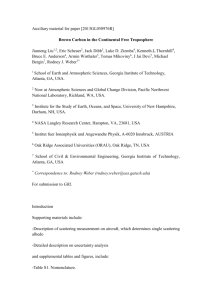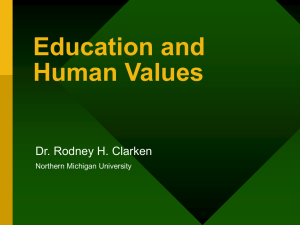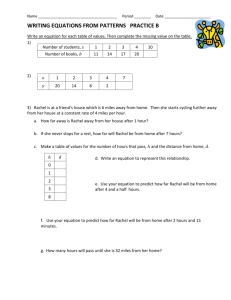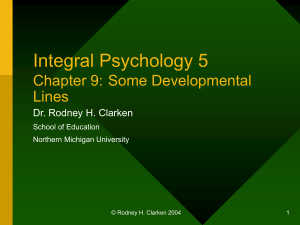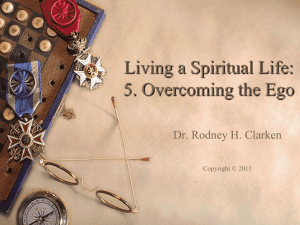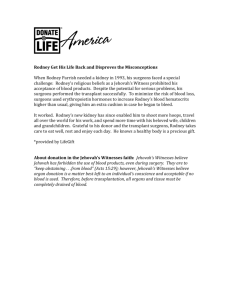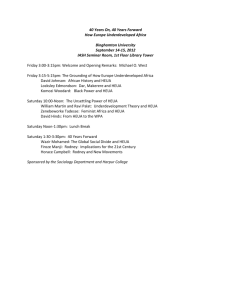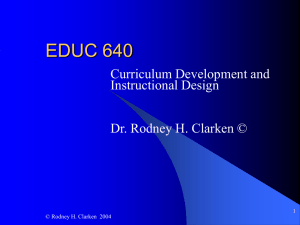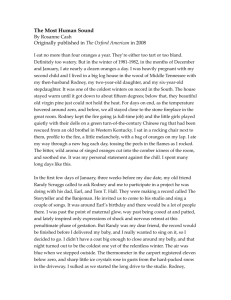Unfolding Pattern of Human Development
advertisement
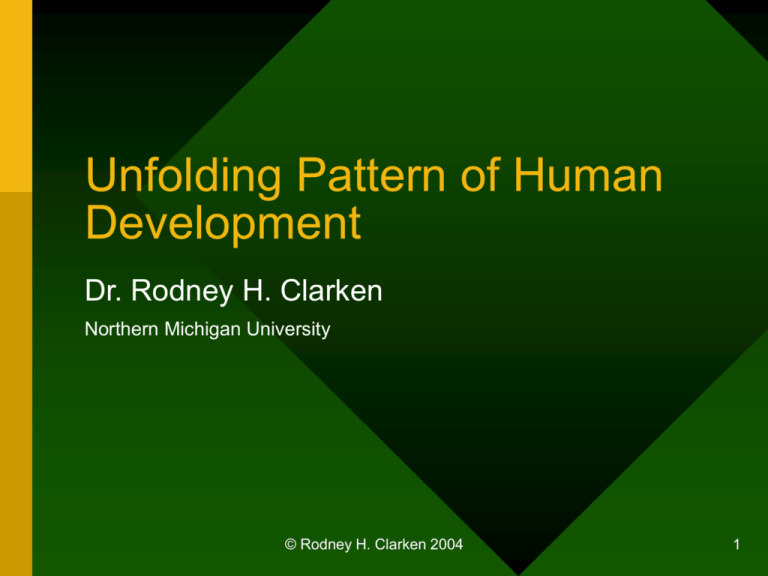
Unfolding Pattern of Human Development Dr. Rodney H. Clarken Northern Michigan University © Rodney H. Clarken 2004 1 This presentation explores • four models and several theories of individual and collective human development. How they can illuminate our understanding of the unfolding patterns of human development with be briefly explored. © Rodney H. Clarken 2004 2 Humans collectively and individually • go through parallel developmental or evolutionary stages. For humanity these processes may have taken centuries or millennia to pass through, whereas an individual may go through an analogous stage in months or years. © Rodney H. Clarken 2004 3 Development may appear to go • in a random or unpredictable pattern, but an order and system are beginning to be uncovered by evolutionary and developmental theorists. • Individual development affects collective development and visa versa. • Individual and collective consciousness develop in similar patterns and in similar stages. © Rodney H. Clarken 2004 4 Developmental Approach • There are many different developmental stages, worldviews and values, some more complex than others • Many problems of one level can only be solved by evolving to a higher level • Facilitating development leads to individual and social progress and welfare © Rodney H. Clarken 2004 5 Model 1: Mineral, Plant, Animal and Human Stages of Body, Mind and Soul • Individually and collectively, humans unfold their perfections gradually starting as a one-celled being, progressing hierarchically through the evolutionary stages of mineral, plant and animal, though a unique creation with all the human potentialities inherent in them from the beginning. © Rodney H. Clarken 2004 6 Stages of Material Development •Mineral •Plant •Animal •Human Matter © Rodney H. Clarken 2004 7 These are the same stages • that the world has gone through evolutionarily over millions of years • First, there was matter that formed into minerals, that over time created the right conditions for the evolution of plants, that were followed by animals, which set the stage for humans. © Rodney H. Clarken 2004 8 The human being is the latest • and highest realm of creation, incorporating in itself the qualities and attributes of the earlier and lower creations: mineral, plant & animal • These physical developments that took billions of years to accomplish in evolution, we pass through in nine months within the womb © Rodney H. Clarken 2004 9 Hierarchy of material creation Time Human Animal Plant Mineral M a t t e r Relative abundance of realm (Adapted from Laszlo) © Rodney H. Clarken 2004 10 Human nature • The human being combines all the lower levels of creation of mineral, pant and animal in its body, and shares their qualities. • Humans add the element of mind, based on a more evolved brain, and have the capacity to transcend them all with its soul. © Rodney H. Clarken 2004 11 Human Nature Mineral Plant •Body Animal Physical •Mind Human Mental •Soul Divine Spiritual Each higher level encompasses and transcends the lower © Rodney H. Clarken 2004 12 Stages of human development • The body, mind and soul each go through a mineral, plant, animal and human stage of development in the process of realizing their full potential. • For more about this model of the unfolding pattern of human development, see “The Process of Becoming Your True Self” (web cast or PowerPoint) © Rodney H. Clarken 2004 13 Model 2: Knowing, Loving and Willing through the Body, Mind and Soul •Know •Body •Mind •Soul •self •Love •True Self •Will © Rodney H. Clarken 2004 14 •Knowing •Thinking •Truth •Head •Understanding •Science mind •Loving soul body •Feeling •Beauty •Heart •Unity •Arts •Willing •Doing •Good •Hand •Justice •Morals © Rodney H. Clarken 2004 15 To learn more about this model of human development go to • http://wwwinstruct.nmu.edu/education/rclarken/PowerPoin tTemporary.htm • For a web cast or PowerPoint presentation • Following we will look at two other models for insights into the pattern of human development © Rodney H. Clarken 2004 16 Model 3: Comparing Individual and Collective Development in Infancy, Childhood, Youth and Adulthood (Prenatal, fetal, embryonic) • Infant • Child • Youth (adolescence) • Adult (maturity) (Elderly, old age) © Rodney H. Clarken 2004 17 Prenatal • Though the fetus may take the appearance and qualities of different levels of creation, i.e., mineral, plant, animal, it is a human being from it beginning as a one-celled creature. Evolutionarily humans have gone through analogous stages over millions of years. © Rodney H. Clarken 2004 18 1. Infancy • As an infant, the human basically is operating at an animal level, focusing on survival, motivated by instincts and physical drives, and gradually developing mastery of the sensory and motor capacities that we share in common with animals. In fact, most animals excel humans in all these areas at this and later stages of development. © Rodney H. Clarken 2004 19 2. Childhood • The mind, which distinguishes humans from animals, begins to gradually develop and consciousness expands going through many stages as it develops. © Rodney H. Clarken 2004 20 3. Youth • At puberty, the body and mind go through changes, triggered by changes in hormones, which further expand human capacities. © Rodney H. Clarken 2004 21 4. Adult • Adulthood is marked by further physiological, mental, psychological, social and moral developments, when human capacities reach there highest levels and attain maturity. © Rodney H. Clarken 2004 22 Old age • The physical and mental capacities begin to wane. © Rodney H. Clarken 2004 23 We will compare individual and social-cultural developmental theories using these four stages 1. Infant 2. Child 3. Youth 4. Adult © Rodney H. Clarken 2004 24 Self Center/Identity 1. Infant (I): Physio and Bio Centered 2. Child (C): Ego and Role Centered 3. Youth (Y): Ethno and Socio Centered 4. Adult (A): World and Principled Centered © Rodney H. Clarken 2004 25 Most theorists recognize these • four commonly understood stages of life as legitimate, but have not attempted to fit their developmental theories to them. I have chosen to use these four stages in life because of their value for generalizing, understanding and comparing. As a result, the different developmental theories may not fit neatly into these four categories. Their stages often overlap with more than one level. I refer you to their original research for a more accurate understanding of the theories included. © Rodney H. Clarken 2004 26 Also, different individuals and societies • develop at different rates and have many different aspects to them. For instance, they may be highly developed (mature adult) in one area and less developed in others (child or youth). In this model, I place most modern societies at a youth developmental level proceeding toward maturity. Individual development will be affected by the culture and society in which it lives. These are relative definitions that have a foundation in subjective and objective individual and collective reality. © Rodney H. Clarken 2004 27 Self Sense (Cook-Greuter) Self Stages (Loevinger) 1. Pre-social, symbiotic, impulsive 2. Self-protective, rule oriented, conformist 3. Self-conscious, goal oriented, conscientious (conformist) 4. Individualistic, autonomous, egowitnessing (integrated) © Rodney H. Clarken 2004 28 Perspectives / Characteristics (Cook-Greuter) 1. None 2. 1st to 2nd person 3. 3rd 1. autistic, undifferentiated 2. self labeling, early roles person 4. 4th and multiple person 3. introspection 4. relativity of self © Rodney H. Clarken 2004 29 Needs (Maslow) 1. Physiological 2. Safety 3. Belongingness 4. Esteem, Self actualization © Rodney H. Clarken 2004 30 Socio-Emotional (Erikson) 1. Trust, Autonomy 2. Initiative, Industry 3. Identity 4. Intimacy, Generativity, Integrity © Rodney H. Clarken 2004 31 Cognitive (Piaget)/Logic (Baldwin) 1. Sensorimotor 1. pre-logical 2. Pre and Concrete operations 2. quasi-logical 3. Formal operations 3. logical 4. extra logical 4. Post-formal operations (polyvalent) © Rodney H. Clarken 2004 32 Moral (Kohlberg) (Gilligan) 1. (Pre moral) 1. (Pre moral) 2. Pre conventional 2. Selfish 3. Conventional 3. Care 4. Post conventional 4. Universal care © Rodney H. Clarken 2004 33 Faith (Fowler)/Religious Systems (Bellah) 1. Preverbal, magical, projective 2. Mythic-literal 3. Conventional, Individual reflexive 1. primitive, archaic 2. historic 3. early modern, modern 4. (emerging) 4. Conjunctive faith, universalizing © Rodney H. Clarken 2004 34 Ego types (Graves) 1. Autistic, magical animistic 2. Egocentric 3. Sociocentric, multiplistic, relativistic/individualistic 4. Systemic (integrated) © Rodney H. Clarken 2004 35 Worldviews (Beck & Cowan) 1. Instinctive, Magical-animistic 2. Power gods, Absolutist-religious 3. Individualistic-achiever, relativistic 4. Systematic-integrative, global-holistic © Rodney H. Clarken 2004 36 Epochs (Habermas) 1. Archaic (familiazation of male), magical animistic (tribal kinship, preconventional law) 2. Mythological (conventional law, early state), mythic-rational (empire) 3. Rational-reflective (nation-state, post conventional law) 4. World Citizen (global) © Rodney H. Clarken 2004 37 Scarce Resource (Habermas) 1. Bodily security (power over nature) 2. Legal security (law and order) 3. Value 4. Meaning © Rodney H. Clarken 2004 38 Socio-cultural (Gebser) 1. Archaic, magic 2. Mythic (Wilber) 1. Archaic, Magictyphonic 2. Mythic-membership 3. Mental 4. Integralaperspectival 3. Rational-egoic 4. Integral-centauric © Rodney H. Clarken 2004 39 Social Organization (A. Taylor) (S. Effendi) 1. Family, clan, band 1. Family 2. Tribe, territorial, theocratic empires 2. Tribal, city state 3. National State 3. Sovereign nation 4. World Order 4. Supra-National © Rodney H. Clarken 2004 40 Techno-economic (Lenski) / Age 1. Hunting and gathering 1. Paleolithic, Mesolithic 2. 2. Neolithic, Copper, Bronze Horticultural, agrarian 3. Industrial 3. Iron, Enlightenment 4. Informational 4. Globalization © Rodney H. Clarken 2004 41 Model 4: Graves’ Developmental Theory/Spiral Dynamics (Beck & Cowan) • Development “is an unfolding, emergent, oscillating, spiraling process.” • Worldviews, mindsets, conceptual frameworks, feelings, motivations, ethics, values, biochemistry, neurological activity, learning, beliefs, etc., are all stage determined © Rodney H. Clarken 2004 42 Individual – Collective behavior • Human behavior tends oscillate between focus on the individual independence where we express self (“me”), and focus on the group interdependence where we sacrifice self (“we”), each attempting to change, assimilate or accommodate the other to achieve greater equilibrium © Rodney H. Clarken 2004 43 Individual vs. collective • Csikszentmihalyi calls it "differentiation" and "integration"; • Val Geist calls it, "dispersal modes" and "maintenance modes." • Howard calls it "diversity generators" and "conformity enforcers." see http://www.educyberpg.com/IEC/caleb.html © Rodney H. Clarken 2004 44 Graves Eight Levels of Existence: What each level seeks 1. physiological satisfaction 5. material pleasure 6. affectionate relations 2. a safe mode of living 3. heroic status, for power and glory 4. for ultimate peace 7. respect of self 8. peace in an incomprehensible world © Rodney H. Clarken 2004 45 Worldview levels (Beck & Cowan) 1. Archaic-Instinctual 2. Animistic/tribalistic 5. Individualisticachiever 6. Relativistic 3. Egocentric 4. Absolutist-religious 7. Systematicintegrative 8. Global-holistic © Rodney H. Clarken 2004 46 1. Archaic-Instinctual (Survival Sense, “me”) • Material and physical self identity; mental barely awakened; pre-social, moral, logical, verbal; trust vs. mistrust • Basic survival (bodily security) needs have priority: food, water, warmth and safety • Seen in infants, senility, survival situations (.1% of adult population*) *All % estimated from Beck & Cowan, taken from Wilber, 2000 © Rodney H. Clarken 2004 47 Band together to stay alive Use instincts and drives just to survive, much like animals First human societies: families form for survival and to perpetuate life, then larger kinship groups and clans Seeking power over nature, simple hunting and gathering Emerged about 100,000 BCE and currently seen is some primitive hunter-gatherer societies, high conflict and disaster areas © Rodney H. Clarken 2004 48 2. Magical-Animistic (Kin Spirits, “we”) • Individual subsumed in group with strong kinship/tribal bonds, symbiotic, autonomy vs. shame and doubt • Preoperational, magical and animistic thinking • Emotional self and punishment/obedience morality emerging • Seen in superstitions, rituals, athletic teams, gangs, tribes (10% pop., 1% power) © Rodney H. Clarken 2004 49 Family, tribe, spirits are honored • Follows spirit being, mystical signs, chief, elders, ancestors, and the clan; Spirits exist in ancestors and bond the family/clan/tribe • Preserves sacred objects, places, events, and memories • Observes rites of passage, seasonal cycles, and tribal customs, advanced hunting and gathering • Emerged about 50,000 BCE and currently seen in some third world and tribal societies © Rodney H. Clarken 2004 50 3. Egocentric (Power Gods, “me”) • Powerful, impulsive, egocentric, heroic; 1st person perspective, initiative vs. guilt and anxiety, naïve hedonism morality • Stands tall, expects attention, demands respect, and calls the shots • Enjoys self to the fullest right now without guilt or remorse • Seen in terrible twos, rebellious youth, frontier mentality, John Wayne rugged individual types, heroes (20% pop., 5% power) © Rodney H. Clarken 2004 51 Power, action, ego driven • The world is a jungle full of threats and predators • Power rules, underlings obey for protection • Breaks free from any domination or constraint to please self as self desires. Conquers, out-foxes, and dominates other aggressive characters • Emerging about 8,000 BCE, seen in feudal kingdoms and empires © Rodney H. Clarken 2004 52 4. Conformist Rule (Truth Force, “we”) • Mythological and concrete operational thinking, industry vs. inferiority, conventional approval of others and law and order morality, ethnocentric • Absolutist-religious, rules and principles with meaning determined by all-powerful Other or Order, • Sacrifice self to the transcendent Cause • Seen in fundamentalism, patriotism, Boy/Girl Scouts, moral majority, codes of chivalry and honor (40% pop., 30% power) © Rodney H. Clarken 2004 53 Purposeful, absolutist, “one right way” • Horticultural and agrarian societies, Rigid social hierarchies, paternalism and Order enforces a code of conduct based on eternal, absolute principles • Righteous living produces stability now and guarantees future reward • Impulsivity is controlled through guilt; everybody has their proper place • Laws, regulations, and discipline build character and moral fiber • Emerged about 3,000 BCE, seen in ancient nations, Puritan America, Confucian China, Dickensian England, Islamic and Christian fundamentalist © Rodney H. Clarken 2004 54 5. Scientific Achievement (Strive Drive, “me”) • Social contract morality and formal operational thinking, 2nd and 3rd person perspectives • Rational, achievement-oriented, individualistic, seeks objective scientific truth and meaning • Science rules, use to advance interests • Seen in liberal self-interest, materialism, cosmetics & fashion industries (30% pop., 50% power) © Rodney H. Clarken 2004 55 Entrepreneurial, materialistic, success-driven • Change and advancement are inherent within the scheme of things • Progresses by learning nature's secrets and seeking out best solutions • Manipulates Earth's resources to create and spread the abundant good life • Optimistic, risk-taking, and self-reliant people deserve success • Societies prosper through strategy, technology, and competitiveness • Emerging about 1700 CE seen in the Enlightenment, the Cold War, Wall Street, colonialism, corporate states, Industrial Revolution, capitalism © Rodney H. Clarken 2004 56 6. The Sensitive Self (Human Bond, “we”) • Formal operational thinking; Pluralistic, relativistic, communitarian, networking, ecological, bonding, subjective; 4th person perspective • Emphasis on dialogue and relationships: Feelings, sensitivity, and caring supersede cold rationality • Universal ethical morality emerging: The human spirit must be freed from greed, dogma, and divisiveness • Seen in diversity, politically correct and human rights movements; collective communities; post modernism; humanistic psychology (10% pop., 15% power) © Rodney H. Clarken 2004 57 Community, harmony, equality and relativity • Spreads the Earth's resources and opportunities equally among all • Reaches decisions through reconciliation and consensus processes • Refreshes spirituality, brings harmony, and enriches human development • Emerging about 1850 CE, seen in World Council of Churches, socialized health care, Greenpeace, post colonialism © Rodney H. Clarken 2004 58 7. Integrative (Flex Flow, “me”) • Post formal operational thinking, universal ethical morality, autonomous integrated self, world centric • Differences integrated into one interdependent order • Systematic-integrative, flexible; Unity in Diversity • Seen in cutting edge thinkers (1% pop., 5% power) © Rodney H. Clarken 2004 59 Natural processes, mutual realities; live for mutuality • Life is a kaleidoscope of natural hierarchies, systems, and forms • The magnificence of existence is valued over material possessions • Flexibility, spontaneity, and functionality have the highest priority • Differences can be integrated into interdependent, natural flows • Understands that chaos and change are natural • Emerged about 1950, seen in visionaries, leaders of thought © Rodney H. Clarken 2004 60 8. Holistic (Global View, “we”) • Universal holistic system thinking, multiple levels interwoven together • Unites feelings with knowledge • Sees multiple levels of interaction • Seen in the very leading edge, Gandhi, Dalai Lama (.1% of pop.) © Rodney H. Clarken 2004 61 Harmony, holism, spirituality • The world is a single, dynamic organism with its own collective mind • Self is both distinct and a blended part of a larger, compassionate whole • Everything connects to everything else in ecological alignments • Energy and information permeate the Earth's total environment • Holistic, intuitive thinking and cooperative actions are to be expected • Emerged about 1970, not yet seen in society © Rodney H. Clarken 2004 62 Eight Value Systems 1 based on biological urges/drives; physical senses dictate the state of being 2 threatening and full of mysterious powers, spirit beings which must be placated and appeased 3 like a jungle where the tough and strong prevail while the weak serve; nature is an adversary 4 controlled by a Higher Power that punishes evil and eventually rewards good works and Right living 5 full of resources to develop and opportunities to make things better and bring prosperity 6 the habitat wherein humanity can find love and purposes through affiliation and sharing 7 a chaotic organism where change is the norm and uncertainty a usual state of being 8 a delicately balanced system of interlocking forces in jeopardy in human hands (adapted from http://www.spiraldynamics.org/Graves/colors.htm) © Rodney H. Clarken 2004 63 What individuals & groups in each level seek out in life 1 survival; biogenic needs satisfaction; reproduction 2 safety/security; protection from harm; family bonds 3 power/action; asserting self to dominate others; control 4 stability/order; obedience to earn later reward; meaning 5 opportunity/success; competing to achieve results; influence 6 harmony/love; joining together for mutual growth; awareness 7 independence/self-worth; fitting a living system; knowing 8 global community/life force; survival of Earth; consciousness (adapted from http://www.spiraldynamics.org/Graves/colors.htm) © Rodney H. Clarken 2004 64 How "rational" people might deal with such a world 1 as natural instincts and reflexes direct; automatic existence 2 according to tradition and ritual ways of group; tribal; animistic 3 asserting self for dominance, conquest, and power; exploitive; egocentric 4 obediently as higher authority and rules direct; absolutist; conforming 5 pragmatically to achieve results and get ahead; multiplistic; achievist 6 responds to human needs; affiliative; relativistic; situational 7 build functional niche to do what one chooses; existential; systemic 8 experiential to join with other like thinkers; holistic; transpersonal (adapted from http://www.spiraldynamics.org/Graves/colors.htm) © Rodney H. Clarken 2004 65 Transitions between levels 1. Survival/meeting biological needs/instinctive drives & urges Awakening of a sense of dependent self in a mysterious and frightening world where being with others means safety 2. Safety/tribal needs/adherence to ritual/obeying chief(s)/harmony/reciprocity Awakening of an egocentric self determined to break the shackles of the family or tribe and become a powerful individual 3. Power/action/excitement/proving individual prowess/shame/cunning dominance Awakening of a purposeful self with guilt in search of meaning in a purposeful existence and reasons why we live and die 4. Purpose/obedience to authority/stability/rules/meaning/guilt/duty Awakening of a pragmatic, independence-seeking self who challenges higher authority and scientifically tests possibilities © Rodney H. Clarken 2004 66 5. Competition/success/making things better/autonomy/adroit control/growth Awakening of a sociocentric self who strives for belonging and acceptance and needs to discover spirit, inner harmony, peace 6. Affiliation/sustainability/collaboration/consciousness/ fulfillment/sharing/connections Awakening of an inquiring, interdependent self who no longer needs approval yet can collaborate when appropriate with diminishing compulsions or fears 7. Being/functionality/discovery/integralism/responsibilities of living/connections Awakening of experiential self who seeks ways of being that use knowledge to restore natural harmony and balance 8. Experience of holism/accept existential realities/integration of life energies--the open-ended Graves theory continues as new thinking systems awaken and coping with life's existential dichotomies activates new neuronal systems http://www.spiraldynamics.org/Graves/colors.htm © Rodney H. Clarken 2004 67 References • This presentation has drawn from the works of Ken Wilber and Abdu’l-Baha. Refer to their writings for more breadth, depth and clarity on these topics, especially Wilber’s Integral Psychology from where most of the comparison data for this presentation were adapted. © Rodney H. Clarken 2004 68 Some web sites used • http://www.educyberpg.com/IEC/caleb.html • http://www.spiraldynamics.org/Graves/col ors.htm • http://www.spiraldynamics.org/learning/fa q.htm © Rodney H. Clarken 2004 69 Contact information Dr. Rodney H. Clarken Director of Field Experiences and Professor, School of Education, Northern Michigan University, 1401 Presque Isle Avenue, Marquette, MI 49855-5348 Tel: 906-227-2160 (secretary), 227-1881 (office), 2262079 (home), Fax: 227-2764 Website with info on courses, papers, Baha'i and China and this presentation: http://wwwinstruct.nmu.edu/education/rclarken © Rodney H. Clarken 2004 70 Compilation of Quotations • From the writings of Abdul-Baha and Shoghi Effendi related to this presentation are available on the following slides. © Rodney H. Clarken 2004 71 “Consciousness of self in man is a gradual process, • and does not start at a definite point. It grows in him in this world and continues to do so in the future spiritual world. "Man can certainly recall past experiences in his evolution, and even when his soul leaves this world it will still remember its past.” (Shoghi Effendi, Lights of Guidance, p. 115) © Rodney H. Clarken 2004 72 “The oneness of humankind • represents the consummation of human evolution -- an evolution that has had its earliest beginnings in the birth of family life, its subsequent development in the achievement of tribal solidarity, leading in turn to the constitution of the city-state, and expanding later into the institution of independent and sovereign nations.” (Shoghi Effendi, The Compilation of Compilations vol II, p. 178) © Rodney H. Clarken 2004 73 “The long ages of infancy and childhood, through which the • human race had to pass, have receded into the background. Humanity is now experiencing the commotions invariably associated with the most turbulent stage of its evolution, the stage of adolescence, when the impetuosity of youth and its vehemence reach their climax, and must gradually be superseded by the calmness, the wisdom, and the maturity that characterize the stage of manhood. Then will the human race reach that stature of ripeness which will enable it to acquire all the powers and capacities upon which its ultimate development must depend. (Shoghi Effendi, The Compilation of Compilations vol II, p. 183) © Rodney H. Clarken 2004 74 “In this present cycle there will be an evolution in civilization • unparalleled in the history of the world. The world of humanity has, heretofore, been in the stage of infancy; now it is approaching maturity. Just as the individual human organism, having attained the period of maturity, reaches its fullest degree of physical strength and ripened intellectual faculties so that in one year of this ripened period there is witnessed an unprecedented measure of development, likewise the world of humanity in this cycle of its completeness and consummation will realize an immeasurable upward progress, and that power of accomplishment whereof each individual human reality is the depository of God -- that outworking Universal Spirit -- like the intellectual faculty, will reveal itself in infinite degrees of perfection.” (Abdu'l-Baha, The Promulgation of Universal Peace, p. 37-38) © Rodney H. Clarken 2004 75 When we find truth, constancy, fidelity, and love, • we are happy; but if we meet with lying, faithlessness, and deceit, we are miserable. • These are all things pertaining to the soul, and are not bodily ills. Thus, it is apparent that the soul, even as the body, has its own individuality. But if the body undergoes a change, the spirit need not be touched. When you break a glass on which the sun shines, the glass is broken, but the sun still shines! If a cage containing a bird is destroyed, the bird is unharmed! If a lamp is broken, the flame can still burn bright! • The same thing applies to the spirit of man. Though death destroy his body, it has no power over his spirit -- this is eternal, everlasting, both birthless and deathless. (Abdu'lBaha, Paris Talks, ©p.Rodney 65-66) H. Clarken 2004 76 Therefore, thank ye God • that ye have come into the plane of existence in this radiant century wherein the bestowals of God are appearing from all directions, when the doors of the Kingdom have been opened unto you, the call of God is being raised, and the virtues of the human world are in the process of unfoldment. (Abdu'l-Baha, The Promulgation of Universal Peace, p. 37) © Rodney H. Clarken 2004 77 From the beginning to the end of his life • man passes through certain periods or stages each of which is marked by certain conditions peculiar to itself. For instance during the period of childhood his conditions and requirements are characteristic of that degree of intelligence and capacity. (Abdu'l-Baha, Foundations of World Unity, p. 9) © Rodney H. Clarken 2004 78 Similarly there are periods and stages • in the life of the aggregate world of humanity which at one time was passing through its degree of childhood, at another its time of youth but now has entered its long presaged period of maturity, the evidences of which are everywhere visible and apparent. Therefore the requirements and conditions of former periods have changed and merged into exigencies which distinctly characterize the present age of the world of mankind. (Abdu'l-Baha, Foundations of World Unity, p. 9) © Rodney H. Clarken 2004 79 “The only real difference that exists • between people is that they are at various stages of development.” (Abdu'lBaha, Paris Talks, p. 170-171) © Rodney H. Clarken 2004 80 “In cycles gone by, • each one of the Manifestations of God hath had His own rank in the world of existence, and each hath represented a stage in the development of humanity. But the Manifestation of the Most Great Name -- may my life be a sacrifice for His loved ones -- was an expression of the coming of age, the maturing of man's inmost reality in this world of being.” (Abdu'l-Baha, Selections from the Writings of Abdu'l-Baha, p. 56) © Rodney H. Clarken 2004 81 “For growth and development • depend on one's powers of intellect and reason, not on one's age or length of days.” (Abdu'l-Baha, Selections from the Writings of Abdu'l-Baha, p. 141) © Rodney H. Clarken 2004 82 For all beings are connected together like a chain; • and reciprocal help, assistance and interaction belonging to the properties of things are the causes of the existence, development and growth of created beings. It is confirmed through evidences and proofs that every being universally acts upon other beings, either absolutely or through association. (Abdu'l-Baha, Some Answered Questions, p. 178-179 ) © Rodney H. Clarken 2004 83 …the development and growth of man on this earth, • until he reached his present perfection, resembled the growth and development of the embryo in the womb of the mother: by degrees it passed from condition to condition, from form to form, from one shape to another, for this is according to the requirement of the universal system and Divine Law. (Abdu'l-Baha, Some Answered Questions, p. 183) © Rodney H. Clarken 2004 84 The wisdom of the appearance of the spirit in the body is this: • the human spirit is a Divine Trust, and it must traverse all conditions, for its passage and movement through the conditions of existence will be the means of its acquiring perfections… • Moreover, these members, these elements, this composition, which are found in the organism of man, are an attraction and magnet for the spirit; it is certain that the spirit will appear in it. So a mirror which is clear will certainly attract the rays of the sun. (Abdu'l-Baha, Some Answered Questions, p. 200-201) © Rodney H. Clarken 2004 85 “It is clear that the reality of mankind is diverse, • that opinions are various and sentiments different; and this difference of opinions, of thoughts, of intelligence, of sentiments among the human species arises from essential necessity; for the differences in the degrees of existence of creatures is one of the necessities of existence, which unfolds itself in infinite forms.” (Abdu'l-Baha, Some Answered Questions, p. 301) © Rodney H. Clarken 2004 86 Love is the: • breath of the Holy Spirit inspired into the human spirit! • cause of the manifestation of the Truth (God) in the phenomenal world! • necessary tie proceeding from the realities of things through divine creation! • means of the most great happiness in both the material and spiritual worlds! (Abdu'l-Baha, Tablets of Abdu'l-Baha v3, p. 525) © Rodney H. Clarken 2004 87 Love is the: • cause of development to every enlightened man! • greatest law in this vast universe of God! • one law which causeth and controlleth order among the existing atoms! • universal magnetic power between the planets and stars shining in the lofty firmament! • cause of unfoldment to a searching mind, of the secrets deposited in the universe by the Infinite! (Abdu'l-Baha, Tablets of Abdu'l-Baha v3, p. 525 526) © Rodney H. Clarken 2004 88 Development and progression • imply gradual stages or degrees. (Abdu'lBaha, The Promulgation of Universal Peace, p. 131) © Rodney H. Clarken 2004 89 If we review history, we will observe that human advancement • has been greatest in the development of material virtues. Civilization is the sign and evidence of this progression. Throughout the world, material civilization has attained truly wonderful heights and degrees of efficiency -- that is to say, the outward powers and virtues of man have greatly developed, but the inner and ideal virtues have been correspondingly delayed and neglected. It is now the time in the history of the world for us to strive and give an impetus to the advancement and development of inner forces -- that is to say, we must arise to service in the world of morality, for human morals are in need of readjustment. We must also render service to the world of intellectuality in order that the minds of men may increase in power and become keener in perception, assisting the intellect of man to attain its supremacy so that the ideal virtues may appear. (Abdu'l-Baha, The Promulgation of Universal Peace, p. 325-326 ) © Rodney H. Clarken 2004 90 Man is the noblest of the creatures. • In his physical organism he possesses the virtues of the mineral kingdom. Likewise, he embodies the augmentative virtue, or power of growth, which characterizes the kingdom of the vegetable. Furthermore, in his degree of physical existence he is qualified with functions and powers peculiar to the animal, beyond which lies the range of his distinctive human mental and spiritual endowment. Considering this wonderful unity of the kingdoms of existence and their embodiment in the highest and noblest creature, why should man be at variance and in conflict with man? (Abdu'l-Baha, The Promulgation of Universal Peace, p. 349) © Rodney H. Clarken 2004 91 Fundamentally all existing things pass through the same degrees • and phases of development, and any given phenomenon embodies all others. An ancient statement of the Arabian philosophers declares that all things are involved in all things. It is evident that each material organism is an aggregate expression of single and simple elements, and a given cellular element or atom has its coursings or journeyings through various and myriad stages of life. (Abdu'l-Baha, The Promulgation of Universal Peace, p. 349) © Rodney H. Clarken 2004 92 All created things have their degree, or stage, of maturity. • The period of maturity in the life of a tree is the time of its fruit bearing. The maturity of a plant is the time of its blossoming and flower. The animal attains a stage of full growth and completeness, and in the human kingdom man reaches his maturity when the lights of intelligence have their greatest power and development. (Abdu'l-Baha, The Promulgation of Universal Peace, p. 438) © Rodney H. Clarken 2004 93 From the beginning to the end of his life man passes through certain periods, • or stages, each of which is marked by certain conditions peculiar to itself. For instance, during the period of childhood his conditions and requirements are characteristic of that degree of intelligence and capacity. After a time he enters the period of youth, in which his former conditions and needs are superseded by new requirements applicable to the advance in his degree. His faculties of observation are broadened and deepened; his intelligent capacities are trained and awakened; the limitations and environment of childhood no longer restrict his energies and accomplishments. (Abdu'l-Baha, The Promulgation of Universal Peace, p. 438) © Rodney H. Clarken 2004 94 At last he passes out of the period of youth • and enters the stage, or station, of maturity, which necessitates another transformation and corresponding advance in his sphere of life activity. New powers and perceptions clothe him, teaching and training commensurate with his progression occupy his mind, special bounties and bestowals descend in proportion to his increased capacities, and his former period of youth and its conditions will no longer satisfy his matured view and vision. (Abdu'l-Baha, The Promulgation of Universal Peace, p. 438) © Rodney H. Clarken 2004 95 Similarly, there are periods and stages in the life of the • aggregate world of humanity, which at one time was passing through its degree of childhood, at another its time of youth but now has entered its long presaged period of maturity, the evidences of which are everywhere visible and apparent. Therefore, the requirements and conditions of former periods have changed and merged into exigencies which distinctly characterize the present age of the world of mankind. That which was applicable to human needs during the early history of the race could neither meet nor satisfy the demands of this day and period of newness and consummation. (Abdu'l-Baha, The Promulgation of Universal Peace, p. 438) © Rodney H. Clarken 2004 96 Humanity has emerged from its former degrees of limitation • and preliminary training. Man must now become imbued with new virtues and powers, new moralities, new capacities. New bounties, bestowals and perfections are awaiting and already descending upon him. The gifts and graces of the period of youth, 439 although timely and sufficient during the adolescence of the world of mankind, are now incapable of meeting the requirements of its maturity. The playthings of childhood and infancy no longer satisfy or interest the adult mind. (Abdu'l-Baha, The Promulgation of Universal Peace, p. 438) © Rodney H. Clarken 2004 97 “Man's evolution is both individual and collective, • because of his twofold relationship to himself and to the society in which he lives. Individual evolution starts with the early stages of one's existence. Consciousness too grows with this evolution.” (Shoghi Effendi, Lights of Guidance, p. 115) © Rodney H. Clarken 2004 98 Oneness of Mankind • It represents the consummation of human evolution -- an evolution that has had its earliest beginnings in the birth of family life, its subsequent development in the achievement of tribal solidarity, leading in turn to the constitution of the city-state, and expanding later into the institution of independent and sovereign nations. (Shoghi Effendi, The World Order of Baha'u'llah, p. 43) © Rodney H. Clarken 2004 99 “Man must walk in many paths • and be subjected to various processes in his evolution upward. Physically he is not born in full stature but passes through consecutive stages of fetus, infant, childhood, youth, maturity and old age. (Abdu'l-Baha, Foundations of World Unity, p. 77) © Rodney H. Clarken 2004 100 “…man was always potentially man, • even when passing through lower stages of evolution. Because he has more powers, and subtler powers than the animal, when he turns towards evil he becomes more vicious than an animal because of these very powers.” (Shoghi Effendi, Lights of Guidance, p. 403) © Rodney H. Clarken 2004 101 “The growth and development of all beings is gradual • this is the universal divine organization and the natural system. The seed does not at once become a tree; the embryo does not at once become a man; the mineral does not suddenly become a stone. No, they grow and develop gradually and attain the limit of perfection.” (Abdu'l-Baha, Some Answered Questions, p. 199-198) © Rodney H. Clarken 2004 102 “The beginning of the existence of man on the terrestrial globe • resembles his formation in the womb of the mother. The embryo in the womb of the mother gradually grows and develops until birth, after which it continues to grow and develop until it reaches the age of discretion and maturity. Though in infancy the signs of the mind and spirit appear in man, they do not reach the degree of perfection; they are imperfect. Only when man attains maturity do the mind and the spirit appear and become evident in utmost perfection.” (Abdu'l-Baha, Some Answered Questions, p. 198) © Rodney H. Clarken 2004 103 The embryo possesses from the first all perfections, • such as the spirit, the mind, the sight, the smell, the taste -- in one word, all the powers -- but they are not visible and become so only by degrees. • Similarly, the terrestrial globe from the beginning was created with all its elements, substances, minerals, atoms and organisms; but these only appeared by degrees: first the mineral, then the plant, afterward the animal, and finally man. (Abdu'l-Baha, Some Answered Questions, p. 199) © Rodney H. Clarken 2004 104 “The human body has one form. • In its composition it has been transferred from one form to another but never possesses two forms at the same time. For example, it has existed in the elemental substances of the mineral kingdom. From the mineral kingdom it has traversed the vegetable kingdom and its constituent substances; from the vegetable kingdom it has risen by evolution into the kingdom of the animal and from thence attained the kingdom of man. After its disintegration and decomposition it will return again to the mineral kingdom,” (Abdu'l-Baha, The Promulgation of Universal Peace, p. 306) © Rodney H. Clarken 2004 105 “Briefly; the journey of the soul is necessary. • The pathway of life is the road which leads to divine knowledge and attainment. Without training and guidance the soul could never progress beyond the conditions of its lower nature which is ignorant and defective. (Abdu'l-Baha, Foundations of World Unity, p. 77) © Rodney H. Clarken 2004 106 “The spirit is changeless, indestructible. • The progress and development of the soul, the joy and sorrow of the soul, are independent of the physical body. • If we are caused joy or pain by a friend, if a love prove true or false, it is the soul that is affected. If our dear ones are far from us -- it is the soul that grieves, and the grief or trouble of the soul may react on the body. • Thus, when the spirit is fed with holy virtues, then is the body joyous; if the soul falls into sin, the body is in torment!” (Abdu'l-Baha, Paris Talks, p. 65) © Rodney H. Clarken 2004 107 From the moment the soul leaves the body • and arrives in the Heavenly World, its evolution is spiritual, and that evolution is: The approaching unto God. • In the physical creation, evolution is from one degree of perfection to another. The mineral passes with its mineral perfections to the vegetable; the vegetable, with its perfections, passes to the animal world, and so on to that of humanity. This world is full of seeming contradictions; in each of these kingdoms (mineral, vegetable and animal) life exists in its degree; though when compared to the life in a man, the earth appears to be dead, yet she, too, lives and has a life of her own. In this world things live and die, and live again in other forms of life, but in the world of the spirit it is quite otherwise. • The soul does not evolve from degree to degree as a law -- it only evolves nearer to God, by the Mercy and Bounty of God. (Abdu'l-Baha, Paris Talks, p. 66) © Rodney H. Clarken 2004 108 The soul after its separation from the body • keeps its individuality and its consciousness both in relation to other souls and to the human beings in the world. (Shoghi Effendi, Lights of Guidance, p. 481) • Evolution in the life of the individual starts with the formation of the human embryo and passes through various stages, and even continues after death in another form. The human spirit is capable of infinite development. Man's identity or rather his individuality is never lost. His reality as a person remains intact throughout the various states of his development. He does not pre-exist in any form before coming into this world. (Shoghi Effendi, Lights of Guidance, p. 536) © Rodney H. Clarken 2004 109 The seed of the spirit starts to grow in the human soul. • This seed must be watered by the outpourings of the Holy Spirit. These gifts of the spirit are received through prayer, meditation, study of the Holy Utterances and service to the Cause of God. The fact of the matter is that service in the Cause is like the plough which ploughs the physical soil when seeds are sown. It is necessary that the soil be ploughed up, so that it can be enriched, and thus cause a stronger growth of the seed. In exactly the same way the evolution of the spirit takes place through ploughing up the soil of the heart so that it is a constant reflection of the Holy Spirit. In this way the human spirit grows and develops by leaps and bounds. (Shoghi Effendi, Lights of Guidance, p. 70) © Rodney H. Clarken 2004 110
